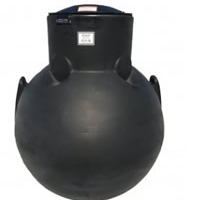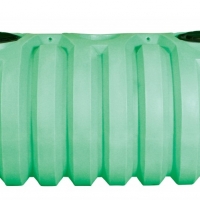Below Ground Tanks FAQ’S
Our tanks are sold through Norwesco distributors. To locate a distributor in your area, click on “Find a Distributor” on the menu at the top of the screen or click on the green “Find a Distributor” tab on the right side of the screen.
You must purchase tanks in full truckload quantities. Contact Norwesco Customer Service and we can put you in contact with a manufacturer’s rep who can give you all of the details.
The tanks shown in the Water & Waste section of our website carry a three year warranty from date of manufacture. Should a defect appear within the warranty period, Norwesco will supply a new, equivalent tank in replacement thereof. Norwesco’s liability is limited to the value of the tank itself and specifically excludes the cost of installation and/or removal or consequential damages.
Most Norwesco tanks are embossed with a serial number that is 1/2″ in height. On a below ground tank you will find the serial number at the “outlet” end of the tank near the edge of the manway. On an above ground tank, you will usually find the serial number near the fill-opening of the tank. To get a general idea of when your tank was manufactured, click on the following link, Understanding Norwesco serial numbers. If you need a specific manufacture date, please contact your Norwesco distributor.
Norwesco uses a linear, high-density polyethylene resin that provides outstanding environmental stress crack resistance. The resin is UV stabilized but by keeping an above ground tank sheltered or indoors you will prolong the life of your tank. Click on the following link for specific information regarding the resin used to manufacture Norwesco above ground water tanks and below ground cistern tanks. Resin Information
Yes, it is safe to store water in the Norwesco above ground tanks and below ground cistern tanks shown on our website. The resin used to manufacture these tanks meets FDA specifications for safe storage of potable water. Click on the following link for specific information regarding the FDA status of the resin. FDA status of resin
NSF International, founded in 1944 as the National Sanitation Foundation, is known for the development of standards, product testing and certification services in the areas of public health, safety and protection of the environment. Norwesco was the first polyethylene tank producer to receive the NSF61 certification, where applicable, for our potable water tanks.
The NSF61 certification process is done on a plant by plant basis. We currently have tanks that are NSF61 certified in five of our manufacturing facilities: Fairfield TX, Hanford CA, Tooele UT, Washougal WA & Lancaster OH. Click on the following link for information regarding the NSF61 status certification for the five facilities listed above. NSF certification
Generally, colors are used to designate one grade or type of tank from another and is for product identification only except for the Black or Dark Green Water tanks. Our standard color for septic tanks is yellow or green; bruiser tanks are light blue and below ground cisterns and above ground water tanks are natural or white. We also offer Black or Dark Green Water Only tanks.
Polyethylene storage tanks have a maximum storage temperature of 120 degrees F. Contents with a temperature in excess of 120 degrees F – even for a short period of time – can weaken the tank’s structural integrity and make it susceptible to deformation and failure.
No, Norwesco products are exempt from the MSDS requirements established in the Hazard Communication section (29 CFR 1910.1200) of the Occupational Safety and Health Administration (OSHA) regulations. Norwesco products are classified as “articles” as referred to in 1910.1200(b)(6)(v) and as defined in 1910.1200(c).
1910.1200(c) “Definitions”
“Article” means a manufactured item other than a fluid or particle: (i) which is formed to a specific shape or design during manufacture; (ii) which has end use function(s) dependent in whole or in part upon its shape or design during end use; and (iii) which under normal conditions of use does not release more than very small quantities, e.g., minute or trace amounts of a hazardous chemical (as determined under paragraph (d) of this section), and does not pose a physical hazard or health risk to employees.
There is no set distance that applies to all tanks or regions. Prior to installing any septic tank, you should check with your local sanitarian for specific lengths for the inlet and outlet tees.
Yes. A cistern is produced from the same mold as a septic tank. The difference is that the cistern is produced with approximately 25% more resin to enable it to meet the demands of frequent pumping and emptying. The other noticeable difference is that all Norwesco cisterns are white in color as opposed to the yellow or green used in our septic tanks. The cisterns are not supplied with plumbing. You must drill the appropriate holes and install adapters or gaskets.
In most state and county regulations or codes there is a direct correlation between the number of bedrooms and the size of the septic tank required. Please check with your local sanitarian or health department prior to purchasing any septic tank.
No, drinking water can only be stored in our below ground white cistern or Bruiser tanks or our above ground tanks.
Our part numbers reflect the different tanks and their plumbing configurations based on state and local health code requirements.
A “CSA” approved tank means that the tank has been tested according to the “Canadian Standards Association”. CSA was the first agency or group in North America to develop standards and requirements that refer specifically to polyethylene septic tanks. Essentially all of the Canadian provinces require CSA approval prior to approving or even evaluating a septic tank.
The installation instructions can be found under the edge of the lid.
The sand/gravel mixture we refer to can generically be called a “pea gravel” mixture. It should be 100% smaller than 1-1/2″ and approximately 50% smaller than 1/4″.
Filling the tank with water while backfilling equalizes the pressure between the outside and the inside of the tank thus minimizing any possible distortion or movement of the tank. Filling a Bruiser or cistern with water while backfilling is recommended but not required.
Norwesco’s septic, cistern and Bruiser tanks are designed for below ground use only. Using the tanks above ground can result in deformation of the tank. It is far more cost-effective to utilize one of Norwesco’s above ground tanks that are specifically designed for above ground use and applications.
For information regarding tank conversion and fitting options, click on the following link, Norwesco Water & Waste Management Tank Uses & Conversion Options.

Physical/Sale Address
1111 Gilman Ave.
Marietta Ohio 45750
Phone: 740-568-4636
Fax: 740-568-4635
sales@fltanks.com
Office Hours
Mon-Fri: 8:00 AM-5:00 PM
Sat-Sun: Closed






